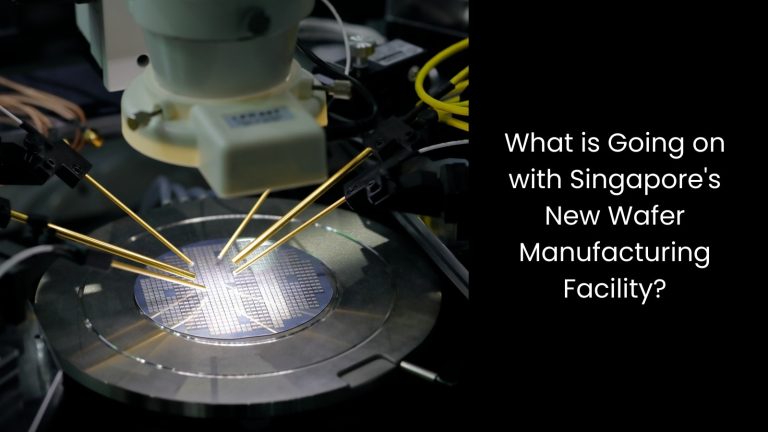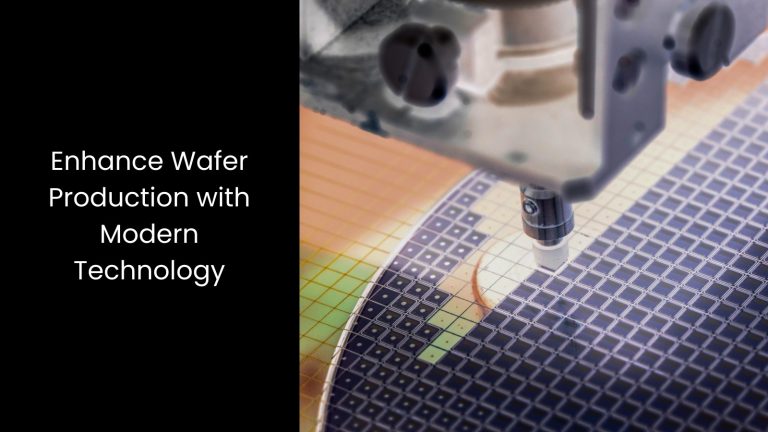Singapore’s position as a global leader in microchip production is set for another exciting chapter with the establishment of a new wafer fabrication facility. This is big breaking news that is circling in the news these days. This cutting-edge addition to Singapore’s technological landscape presents a significant opportunity to push the boundaries of efficiency, yield, and sustainability within the semiconductor industry. According to the news reports, this new initiative helps embrace the strategic integration of advanced technologies, and this new facility can become a beacon of innovation, propelling Singapore further ahead in the competitive global market.
In this article, we will discover strategies to optimise the operations of this new wafer manufacturing facility for maximum profitability.
We will know
- What is Going on with Singapore’s New Wafer Manufacturing Facility?
- Top 5 Advanced Technologies to Optimise New Wafer Manufacturing Facility Operations
- Artificial Intelligence
- Automation and Robotics
- Internet of Things (IoT)
- Quantum Computing
- Green Manufacturing Technologies
- Cerexio Advanced Solutions for the Wafer Manufacturing Industry
- Enhance Wafer Production with Modern Technology
What is Going on with Singapore's New Wafer Manufacturing Facility?

- The latest news is that Siltronic, a German company, opened a $2.9 billion manufacturing facility in Singapore on June 12, 2024. This 150,000-square-metre factory in Tampines, their third in Singapore, makes silicon wafers for semiconductors used in mobile devices, electric vehicles, and data centres.
- According to the authorities in Singapore, by the end of 2024, the plant will produce up to 100,000 wafers a month and introduce advanced silicon wafer epitaxy technology to boost electrical conductivity.
- Currently, the plant employs 300 people, and this number will double to 600 by 2028.
- There is a huge demand for semiconductors in today’s world due to trends like artificial intelligence and digitalisation. This is the main reason for this company to open up a new facility in Singapore again.
- This is known to be a great place for its good workforce and stable infrastructure.
- During his conversation about this, Deputy Prime Minister Heng Swee Keat emphasised the importance of semiconductors in the digital and green revolutions, highlighting their role in developing AI and green technologies.
- If we talk about Singapore’s semiconductor industry, the latter contributes 40% to its manufacturing value.
Top 5 Advanced Technologies to Optimise New Wafer Manufacturing Facility Operations

Artificial Intelligence
Just like in every other industry in the world, Artificial Intelligence can surely optimise operations at Singapore’s new wafer manufacturing facility. Let us explain how this is possible.
First, AI can enhance production efficiency by using machine learning algorithms to analyse data from various sensors and machines. These algorithms detect patterns and predict potential issues, allowing for proactive maintenance and reducing downtime.
In another way, AI-powered robots can automate repetitive tasks, ensuring precision and speed while minimising human error. Also, AI can improve quality control by using computer vision to inspect wafers for defects, ensuring only high-quality products proceed through the production line.
Plus, in logistics, AI can simplify supply chain management by predicting demand, optimising inventory levels, and scheduling timely deliveries. Furthermore, AI-driven data analytics can provide insights into energy consumption and resource utilisation. This will surely help to reduce waste and lower costs.
Also, if they can integrate AI into environmental monitoring systems, the facility can maintain optimal conditions for wafer production, such as temperature and humidity control. AI can also enhance cybersecurity by detecting and responding to potential threats in real-time, safeguarding sensitive manufacturing data.
Automation and Robotics
When discovering new ways to revolutionise operations, this should receive a top spot on that list.
By deploying industrial robots equipped with precise actuators and sensors, tasks such as wafer handling, inspection, and packaging can be automated with high speed and accuracy. You know that collaborative robots, or cobots, can work alongside human operators to perform intricate assembly tasks, improving efficiency and safety.
Apart from that, Automated guided vehicles (AGVs) can transport materials and finished wafers between different production stages. This will reduce manual handling and optimise logistics.
On the other hand, vision-guided robots use advanced computer vision systems to visually inspect wafers for defects, ensuring only flawless products proceed and enhancing quality control. Additionally, robotic arms equipped with AI algorithms can perform complex tasks like wafer alignment and stacking with unparalleled precision.
This robust integration of robotics into the manufacturing process minimises human error. It also increases throughput and reduces operational costs. Real-time data from robotic systems can be analysed to optimise workflows and predict maintenance needs, ensuring continuous operation and maximising productivity.
Internet of Things (IoT)
As it functions with embedded sensors and connected devices throughout the facility, IoT enables real-time monitoring and control of critical parameters like temperature, humidity, and equipment performance.
Sensors gather data and transmit it wirelessly to a centralised system, where AI algorithms analyse the information to identify patterns and anomalies. This data-driven approach allows for predictive maintenance, where potential equipment failures can be anticipated and preemptively addressed. This way, it will help minimise downtime and optimise productivity.
It goes without saying that the IoT facilitates remote monitoring, allowing engineers to access real-time operational data and make informed decisions from anywhere. In another way, automated alerts and notifications ensure timely responses to deviations from optimal conditions. The latter enhances efficiency and reduces operational risks.
We should not forget that IoT-enabled smart devices can also optimise energy consumption by adjusting lighting, heating, and cooling systems based on occupancy and environmental conditions, which will promote sustainability and cost savings.
Furthermore, IoT enhances supply chain management by tracking inventory levels in real time, optimising logistics, and ensuring seamless production flow.
Quantum Computing
Have you ever thought of Quantum Computing technology when you think of new ways to revolutionise operations at Singapore’s newly established wafer manufacturing facility? This can surely speed up complex calculations necessary for optimising semiconductor designs and production processes.
It works like this: Quantum computers utilise quantum bits (qubits) that can exist in multiple states simultaneously. This allows them to process vast amounts of data and perform intricate simulations that classical computers struggle with. This capability allows for faster modelling of semiconductor materials and structures, leading to more efficient designs and improved manufacturing techniques.
Also, quantum computing can enhance machine learning algorithms used for quality control and predictive maintenance due to its ability to analyse large datasets with unprecedented accuracy and speed. This capability enables the facility to detect subtle defects in wafers during the early stages of production, ensuring higher yields of flawless semiconductor products.
Green Manufacturing Technologies
The new wafer facility must implement sustainable practices that reduce environmental impact and improve resource efficiency to balance out profitability with sustainability. This is why they need advanced techniques, such as renewable energy sources like solar panels and wind turbines, that can power the facility. These things will reduce reliance on fossil fuels and lower carbon emissions.
Plus, energy-efficient equipment and processes, such as LED lighting and optimised HVAC systems, minimise energy consumption during wafer production. On the other hand, recycling and waste reduction initiatives can reclaim valuable materials from manufacturing processes, reduce landfill waste, and conserve resources.
Another strategy is that water recycling systems and advanced filtration technologies can efficiently manage water usage, ensuring minimal waste and environmental impact.
As you can see, adopting these green manufacturing practices not only aligns with regulatory requirements but also enhances the facility’s corporate social responsibility profile, appealing to environmentally conscious stakeholders and consumers.
Cerexio Advanced Solutions for the Wafer Manufacturing Industry

Cerexio has introduced many software solutions that can back up the operations of any sort of manufacturing network, such as the Manufacturing Execution System, Predictive Maintenance, Warehouse Management System, and so on. As our solutions put a lot of weight on sustainability, these will help the wafer industry keep its green footprint on the global map.
Enhance Wafer Production with Modern Technology

There should be a network of potent digital tools, as wafer manufacturing is truly a complex process. With the right and modern technologies, every aspect can be streamlined easily, and the manufacturers can extract the most of the processes via these tools.
